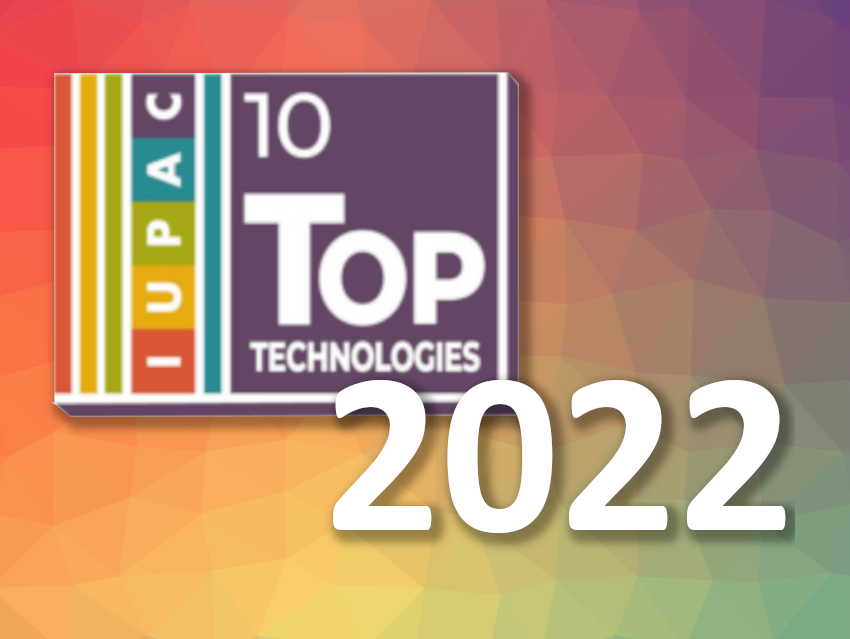The International Union of Pure and Applied Chemistry (IUPAC) has announced the 2022 Top Ten Emerging Technologies in Chemistry finalists. With this project, started in 2019, IUPAC aims to showcase the value of chemistry and inform the general public as to how the chemical sciences contribute to the well-being of society and sustainability. The jury selects emerging technologies, i.e., those at a stage between a new scientific discovery and a fully commercialized technology, and highlights those with the greatest capacity to provide new opportunities and transform our world.
The 2022 Top Ten Emerging Technologies in Chemistry are (in alphabetical order):
- Aerogels
Aerogels are ultralight porous materials. They are derived from gels, but instead of a liquid component, a gas is used. They are light, yet mechanically strong, and can be used, e.g., as thermal insulators or in environmental remediation. - Fiber Batteries
Fiber batteries differ from traditional batteries in their design: Instead of stacked components, fiber batteries have an almost one-dimensional configuration, with intertwined wires as electrodes, protected by a polymeric coating that also seals in the electrolyte. The resulting fibers can be woven to give battery “fabrics”, which could be useful, e.g., in creating flexible and breathable wearable electronics. - Film-Based Fluorescent Sensors
In film-based fluorescent sensors, fluorescent molecules are immobilized on suitable surfaces, forming films that react to external stimuli. The sensors are small and portable, as well as efficient and easy to operate. They can be useful, e.g., for the detection of contaminant gases such as NOx and volatile organic compounds (VOCs). - Liquid Solar Fuels
Analogous to photosynthesis in nature, “artificial photosynthesis” methods can be used to produce energy-rich substances, such as fuels, using renewable solar energy. This approach could be useful to store solar energy, which is produced intermittently—a strategy sometimes called “bottling renewables”. - Nanoparticle Megalibraries
Nanoparticle megalibraries can be used for the high-throughput screening of nanoparticles that vary in composition and structure. The are created using a nanoparticle deposition technique known as polymer pen lithography. In this approach, different metal salts, dissolved in polymeric inks, are deposited onto a surface using thousands of microscopic tips. Then, heat is used to create metal nanoparticles from the deposited material. The approach can be useful, e.g., in catalyst development. - Nanozymes
Nanozymes are nanomaterials with some of the characteristics of natural enzymes. They can be used in traditional catalysis applications, but also, e.g., in diagnostics or sensing. Compared with enzymes, nanozymes can have advantages in terms of stability, recyclability, and cost. - Rational Vaccines with SNA
Spherical nucleic acids, or SNAs, consist of strands of nucleic acids attached to different kinds of nanostructures. The properties of SNAs differ from the corresponding linear nucleic acids. SNAs can, for example, enter cells more easily. This technology could have uses, e.g., in vaccinations and cancer immunotherapy. - Sodium-Ion Batteries
Improved battery technologies are important, e.g., for the storage of renewable energies. Sodium is more abundant than the commonly used lithium, which suffers from limited supply. Also, the components of sodium-ion batteries can be easily disassembled, reconditioned, and recycled. Thus, this battery type offers opportunities in terms of sustainability and circular economy. - Textile Displays
Textile displays could lead to smart fabrics and new wearable electronic devices. They incorporate fibers that can emit light, which are intertwined to form flexible, fabric-like displays. Similar to fiber batteries, this approach could allow for flexible and breathable wearable electronics. - VR-Enabled Interactive Modeling
Virtual reality (VR) technology allows researchers to enter an imaginary room populated with giant molecules, and manipulate them using wireless controllers. Such a three-dimensional, interactive, immersive experience can improve the understanding of chemical reactions and speed up molecular modeling tasks.
- IUPAC Top Ten Emerging Technologies in Chemistry
- IUPAC Top Ten Emerging Technologies in Chemistry 2022,
Fernando Gomollón-Bel,
Chem. Int. 2022, 44 (4), 4-13.
https://doi.org/10.1515/ci-2022-0402



Es la realidad emergente de la ciencia de estos últimos años